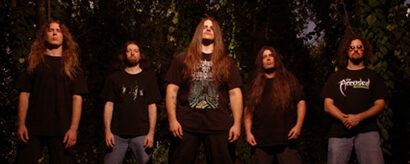For this article I’ve studied the ins and outs of ‘grunting’, or ‘growling’. I also interviewed six singers who are using this technique. Grunting is a form of vocal usage that produces a vocal sound that can be best compared with loud growling. Although many hard rock and heavy metal music styles are characterized by raw singing and screaming, grunting is actually more typical for a sub style called death metal. Although I wrote this article a while ago it’s still interesting to read what the singers explain about the technique.
Research
There are no traces of extensive research done on this subject. The only information I found on the physiological aspects of grunting is that the sound is produced by vibrations of the supra-glottal structures, alternatively called the false vocal cords, and supported by the true vocal folds. The position of the epiglottis plays a role too. There seems to be a connection with the growling sound by singers like Louis Armstrong, but also with ‘throat singing’, typical of Tibetan monks. However, I’m not ready to decide how exactly these techniques relate to each other.
In the News
Grunting has recently been given some attention by the press, not in the last place because of the Dutch Grunting Championship. Dutch newspapers like the NRC and the Brabants Dagblad have dedicated articles to the phenomenon, and speech therapist Piet Kooijman of the Nijmegen University Medical Center St. Radboud, was in the news with his warning that ‘grunting is traumatizing the voice’. Two years ago the first grunter participated in the Idols auditions, (made it to the finals and declined the honor with thanks).

Roots
Death metal music originates in punk, which explains its anarchistic character. Virtuoso guitar parts, quick tempo variations and double bass drum parts. And the volume? High. Very high. The atmosphere of the music is threatening; the performance theatrical. The sub culture the music is a part of, is characterized by an aggressive effect cultivated by black clothing with provocative prints and metal accessories, and face piercings. The lyrics fit this description and are usually about gloom and doom.
Listening
Without surprises, listening to death metal challenged my stamina. The more extreme the vocal usage, the greater the challenge to approach the music with an open mind. The sound is harsh, gurgling, nearly subterrestrial and often ‘thrown up’ with extreme force. I did enjoy the combination of audio and visual performance (for example through youtube.com), as this gives a more complete context for what is going on. Also the energy, devotion and theatrical aspect of the performance as a whole, were interesting.
Serious Stuff
The extreme character of the grunting sounds produced by the death metal vocalists have a somewhat giggly effect on non-insiders. Besides, the aggressive image tends to put people off. And so, all six male grunters I interviewed for this article were pleasantly surprised to see that somebody outside their own circle would be interested in what they’re doing. These people are utterly serious about practicing their grunting and have a lot of information to share; one of them has even dedicated his Master’s thesis to the subject. For some information they referred me on, and I was given audio samples. It needs mentioning that there are female grunters as well as male ones. Arch Enemys’ female singer Angela Gossow is a great example. Search for ‘grunting’ on youtube.com, and you’ll discover that even delicate Asian girls master the techniques of grunting.

The Sound
By interviewing grunters and by listening to and watching grunting on internet, I discovered grunting has created its own vocal culture with a clear distinction of different sound types. For example, high and mid screams, pig screams, inhale screams, talking screams, death grunts, black metal screams, deathcore shouts, southern rockscreams, screamos and hardcore grunts. I figured out that the words high, mid and low were referring to the timbre rather than the root tone. Where distinguishable, this is usually rather low, somewhere between D en G minor. Sounds can be very different. Death grunts for example, are dominated by a sub harmonic sound in such manner that all that can be distinguished are frightful sounding growls, without any audible key. Lyrics are difficult to hear and the vocal parts best compare with a volcanic eruption. However, other forms of grunting are most easy to understand, with a clear key and rhythm.
Distortion for singers
The musicians I interviewed have given me interesting descriptions of what grunting is: ‘growling throat singing’, ‘colored noise’ and ‘an aggressive way of screaming’. Notable is that all of them started grunting around the age of fifteen. Most have been practicing grunters for about ten years. Theatrics, the evil, inhuman and brutal character of the sound, the immense diversity of sounds, the feeling of ‘superiority’ that comes with the sound, and the enormous physical efforts needed, are attractive aspects for the grunters. ‘Consider grunting a kind of distortion for singers. The fun part is that the vocalist gets to contribute in a unique way, which therefore does the music a great deal of justice’. Another grunter finds the ‘atonality of the music interesting as it offers great opportunities from a composers’ point of view’, because guitarists are ultimately flexible in the choice of their music notes.

Autodidactic
All the interviewed musicians are self-taught. They listen to recordings of other grunters and try to copy them. The imitated sounds are usually immediately tried with their own bands. Some ask fellow singers for useful advice. One of the grunter interviewees told me he drew a lot of benefit out of studying ‘undertone singing’ (referring to ‘throatsinging’).
Grunting requires extensive practicing and, if done so, can be improved continuously. Some who have been into it for years, are still looking for the best technique. Initially a lot of the grunters experienced pain, or were getting hoarse and tired. But now, some of them are able to sing for up to 12 hours a day, without any pains or aches. Others manage to do tours and perform five or six times a week. Others though, stick to a maximum of 1.5 hours a day. The more diverse the vocal usage, for example by alternating grunting and clean singing, the harder it is. It’s common practice that bands have different singers for grunt vocals and clean singing. Another thing is that in order to make sure the grunts are understood, more advanced techniques and, sometimes years of practicing are necessary.
Volume
All of those interviewed indicated they’re alternating different metal singing styles. The scream (“a very high, blood curdling screech’) appears to be the favorite, but also the usage of different timbres and pitches within grunting style. Two of the interviewed singers actually alternate grunting and clean singing. An unambiguous answer to my wanting to know if grunting is necessarily loud, seems to be hard to give. Some say it needs to be loud. Others say both loud and soft is possible, and that it possibly depends on the key. Yet another grunter tells me the actual grunting is never that loud; it’s the mic that amplifies the sound. Someone was of the opinion that it’s essential to control the volume if you want to conserve your voice.
Techniques
Not all grunters are able to give more information about the technique, yet others are very specific about how they do it. All of the grunters agree that one important condition is to be able to control your breath. Once you have mastered that, the actual grunting shouldn’t take too much breath. The whole body is made strong, the head hangs slightly forward (known as the ‘gorilla position’), and the lips make somewhat of a pout. Most of the tension is felt in the belly, the neck and high up in the throat (jaw level). All grunters have got the feeling the throat is ‘open’. One of them says that ‘the tongue becomes fat and is positioned in the back of the mouth, with its sides pressed to the upper molars’. Video footage shows that the grunting is done with wide open mouths.

Microphones
Although the grunters are of the opinion that which type of microphone is used doesn’t make much of a difference, most prefer to use a dynamic mic on stage because of the high volumes produced. What is more important is how the microphone is used, as this influences the sound. A darker and possibly slightly distorted sound can be achieved by cupping your hands around the microphone head. The further the distance to the microphone the thinner and softer the sound. It’s not surprising that most grunters keep the mic as closely as possible to the lips. With sufficient amplification there is less physical strain and less stress on the voice. Compression can play an important role too. Finally the grunters note that the mic is a theatrical tool for them too. ‘It has a lot to do with acting, if not playing an instrument you’re not just holding the mic, you are often grabbing it really hard, like something to hold on to’.
Vocal Stress
Inevitably we came to discuss the subject of vocal stress. An average vocalist could probably not face up to using their voices grunting, especially knowing the activity could be the cause of vocal problems. But if you listen to http://youtube.com/watch?v=IdjoK8D6DwI&feature=related on youtube, you will hear that the afore mentioned Angela Gossow has conserved her spoken voice very well. Other examples are Eric Kalsbeek of Textures, who also combines grunting with clean singing. When listening to recordings of his band, on for instance, myspace.com, it’s obvious that he is another example of somebody who has kept a healthy (and beautiful!) voice. In other words, grunting doesn’t necessarily lead to traumatized vocal chords. The same conclusion is supported in Julian McGlashans’ preparatory scientific research. A presentation of this research, with animations of the glottis, can be found on internet (refer to info below).
A possible deterioration of the voice is something a lot of grunters seem to accept as a fact. The older generation of grunters especially, believe it’s not the done thing to take classes. The younger, and specifically the more professional grunters, underline the importance of proper warmup exercises, adequate breathing techniques and sufficient liquid intake. They do take it seriously to prevent vocal damage as much as possible.
Impact on the Voice
What do the interviewed grunters have to say to this? Has grunting caused any problems for them? In situations where a lot of grunting is required, they do notice the impact after a few days. Adequate warmup exercises are very important, as is keeping the body hydrated and allowing for sufficient breaks during recording sessions. It’s essential to practice at home to keep the voice in shape. Gigs tend to be very intense and stressing experiences, with an impact on the clean singing voice, which can become unstable and hoarse very quickly. To my question if their voices have changed by practicing grunting, the reaction was positive, implying the voice has become deeper and slightly hoarse. When a lot of grunting is happening, they’re then struggling to reach the high notes. One of the interviewed musicians admits that his voice became more supple and stable when he stopped grunting after eight years. Soft singing has become easier too.

Warming Up
The reason a lot of grunters will sooner or later experience problems is because they’re not properly prepared. It’s a strenuous technique, which needs to be built up slowly, especially when it comes to volume. Tension on the throat should be avoided as much as possible. ‘A lot of the kids think they’re too good to take lessons. Grunt lessons, are you kidding?’ It’s important not to start too young, says one grunter, for it gets easier when you’re a little older. The sound that a lot of women produce by grunting whilst inhaling, called the inward-grunt, is also hugely traumatizing the vocal cords and causing many other problems.
Is it for everybody?
This technique can be learnt by everybody but some will have more talent for it than others. ‘My ex-girlfriend, who’s more the singer/songwriter sweet type of girl, has learnt how to do it too!’ Not all interviewed grunters are convinced they could teach the technique to others. Sure, there’s advice to be given to avoid typical beginners’ mistakes. Two say they would go by the sound, and then try to explain how the sound should come to be. Another one notes that the difference with normal vocal classes isn’t really that big. ‘It’s also really just a matter of trying all sorts of techniques to find out what sounds can be produced’. Somebody remarks that the perfect teacher is not only schooled but also a grunter him or herself.
Grunt Coaches
Right now, there aren’t that many grunt coaches, which, in fact, isn’t all that surprising: In order to train the technique to others, it makes sense to master it yourself, doesn’t it? One of the disadvantages though, is that serious grunters can cause damage to the clean singing voice. Only two of the people I interviewed alternate grunting and clean singing, which is difficult (but not impossible) to do, so they say. All of the others never use their clean singing voice.
One of the few vocal teachers that are occupied with this genre of music, is American instructor Melissa Cross. Some consider her DVD ‘The Zen of Screaming’ the bible for heavy metal singers. Others have points of critique because the part of the DVD that is about screaming wouldn’t be extreme enough to compare with death metal. Another medium with exercises and more information on grunting is a book by Cathrine Sadolin, ‘Complete Vocal Technique’. She uses the term ‘growl’ for what we’ve been calling ‘grunt’. Her indications work, though with a lighter and less aggressive result than used by most death metal singers. Hardcore grunters are likely to prefer more extremity..

Preliminary Conclusion
My preliminary conclusion is that those who are prepared to see beyond the cautiously created evil image, and buy some earplugs if needed, could very well discover an interesting vocal phenomenon in grunting. A phenomenon that for some grunters implies total devotion to the emotional aspects, without even considering the vocal consequences, and in which others find a special way to practice rhythmical speaking whilst improving audibility and working on the creation of various different sounds. Yet another group of grunters is formed by those who create a technical and delicate balance between frightful death grunts and beautiful clear rock vocals, without any apparent effort, in an overall extreme theatrical setting. There’s nothing funny about grunting. This serious phenomenon seriously deserves respect. I’m of the opinion that it’s too soon to decide whether grunting is traumatizing the voice or not. Virtually all grunters are self-taught and learn from each other by imitation. The necessary coaching and research will hopefully reveal more about this in the not too distant future.
Thanks
I would like to thank Eric Kalsbeek, Chris van der Valk, Florian Maier, Peter van der Ploeg, Michel Nienhuis, Mathias Riediger for answering my questions and all the information they gave me.
Published in the magazine of the Dutch Association of Vocal Teachers. October 2008